The titanic fashion era existed for a short while, from 1910 to 1912 to be exact. But this era can be designated as a more fashionable era than the previous Edwardian era. Although the titanic period existed for a very short time, this era left its unique landmarks on fashion for luxury, elegance, and class.
The titanic was on board with 3 classes of women. Among all of them, the 1st class ticket bearers were the richest for sure. 1st class women passengers of the Titanic were not only rich but also they had a very careful sense of fashion. They wanted to have perfection in each and every dress according to the events. Usually, the first-class passenger women changed their dresses 3 to 4 times, at different times of the day. They had morning dresses for their breakfast time, day dresses to wear during the day, and nightdresses for dinner parties or dance.
In the morning, a tailored suit along with other accessories was the most sensible choice for Titanic ladies. In the previous article, there was a detailed discussion about the titanic 1st class women’s morning dresses and accessories. This article is about the other dresses they wore at different times of the day. You can also find out about Titanic 2nd or 3rd class women passenger’s fashion in this link.
Titanic fashion: 1st class passenger’s day or afternoon dresses:
The day time was the time for lunch, which was very different from nowadays. The lunchtimes usually were 2 to 3 hours long, consisting of at least 3 courses. This was a very formal event for both titanic men and women. So, the titanic women thought of changing their morning tailored suits into something more proper, like a dress or a gown, to be more formal.
Titanic outfits had a clear reflection of Edwardian day dresses. But the dresses had already changed their silhouettes from s curved to straight. These day dresses had a high waistline with elbow-length sleeves and V neckline. Modesty was always the first rule of day dresses. For the V necklines, these dresses may sometimes seem more open. So they used “Chemisettes”, which was like an overcoat, but lighter. It was basically a semitransparent upper chest covering dress.
Hobble skirts were the general and common Titanic fashion. They had slits or pleats to make them comfortable to wear. Asymmetrical draping or tunics were used to decorate these skirts. Skirts were preferable in dark colors like red, blue, green, or purple, rather than light pastel colors. They used rich fabrics like velvet to make these skirts.
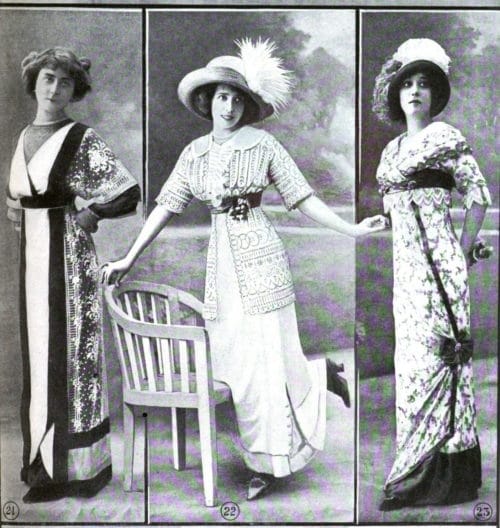
Tea Dress
In the afternoon, the titanic ladies liked to wear a special kind of dress while having their afternoon tea. These were renowned as the tea dresses. Tea gowns were found in the titanic women’s closet as a regular dress. Tea dresses were almost like the robes, they had a very loose-fitting and were worn without any corset. These dresses were very lightweight and comfortable to wear. The focus of the tea gowns was to ensure the flexible movement of the body and relax the mind before dressing up again for the dinner parties. A lace made or cotton made tea gown in the summer tea parties was always the right choice. In the winter, heavier fabrics were used to make these tea gowns
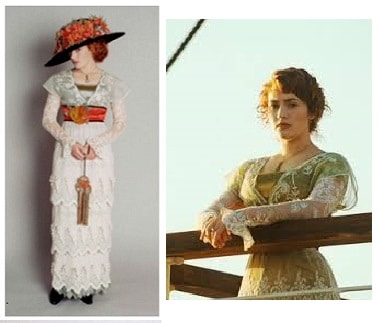
What accessories were used with the afternoon dresses in titanic fashion?
They used simpler accessories with these afternoon dresses, as being formal was usually required. They might use a simple brooch on the bodice of the dress. If not, they might wear a single string long bead necklace. Hats were a must. They were made from felt or furs and decorated with ostrich or aigrette feathers and ribbons. But they were smaller in size than the usual hats. Lightweight shoes were the most sensible choice. These shoes had fabric designs and short heels. Light-colored gloves were always worn to complete their fashion.
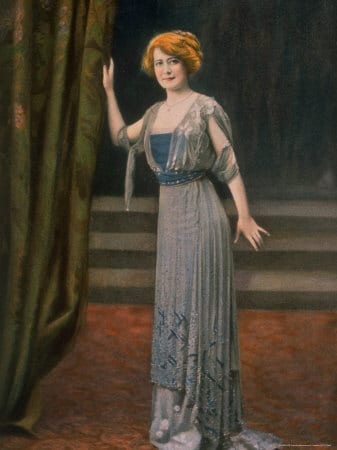
These dresses were worn by the titanic women for 3 to 4 hours, till the evening to be exact. When it started to get darker, it was time to change their dress again. This is the time for their Dinner Gowns!
So, what made these dinner gowns unique?
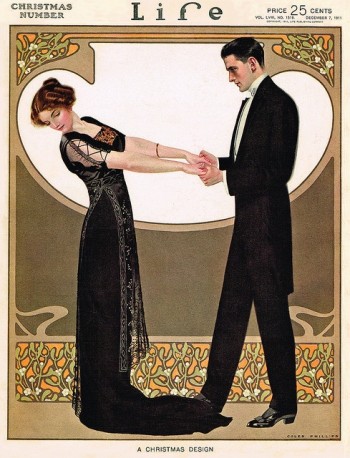
Each night, the 1st class women liked to wear fashionable and different dresses, as dinner was another formal event which was also very luxurious. Each and every 1st class woman tried to look one of a kind, so they picked their dresses and accessories very cautiously. From the hats to the shoes, each and every detail of their dress had to have the touch of luxury and stylishness during this time. They usually used chemises made by cotton, but for dinner, they used the silk chemises. The corsets were also fancier and even the stockings were made from silk instead of wool. Crepe de chine or Japanese silk petticoats were more preferable.
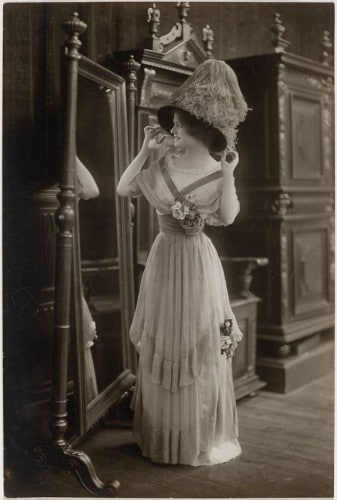
The bodices used for the dinner parties were kind of similar to the day dress bodices. They had the crossed-over design, V or lower necklines, and sleeves were not very long. So like the afternoon dresses, a semitransparent chiffon or silk chemisettes were worn with a dress, to ensure modesty. Skirts started to be straighter with draping or tunics layers on the top. The most commonly used fabrics were satin, silk, velvet, chiffon, or gauze. Embroideries, ribbons, bows, fabric flowers were used to adorn them. Eye-catchy colors became popular for these skirts. Red, blue, or green gained popularity but soft pastel colors were still popular.
As the time passes by…
Around 1912, the Titanic style dresses or gowns started to have bead designs. These beads were matched with the color and tone of the dress. The younger single women wore dresses with long V or square necklines and shorter sleeves. The older women preferred less revealing dresses.
The mature women were free to wear the revealing dresses, but they liked to wear the gowns with a classic Victorian hourglass silhouette. Maybe this is because the women who were born in the Victorian era found this style more familiar. The new revealing dress designs were impeccable for the young women, but a little too much for the older ones. So sometimes they mixed up the two styles to create something new.

Accessories with the dinner dress
Louis-style heel shoes were the common ones. These had toes with almond shapes and high tongues. These shoes were not very different from the afternoon shoes. But dinner shoes had jeweled chains, where afternoon shoes were simpler. Sometimes they had matching dyed shoes with the dress. If they didn’t have to dance, they used the mule slippers for the semi formal events.
Unlike the afternoon, at dinner parties, they used all kinds of fancy pieces of jewelry while maintaining the style. Everything was about showing off the wealth and class, so they wore the richest pieces of jewelry with diamonds, pearls, or jet beads. This is the time they were free to wear chokers, hair ornaments, long earrings, bracelets, rings, whatever they want, just making sure that they weren’t being extra and they were not out of fashion. They also styled their hair differently for the dinner parties, with feathers or ribbons. This time, they did not wear any hats, rather they liked their head full of curls binding on the top of their head adorned with pearl chains like a crown.
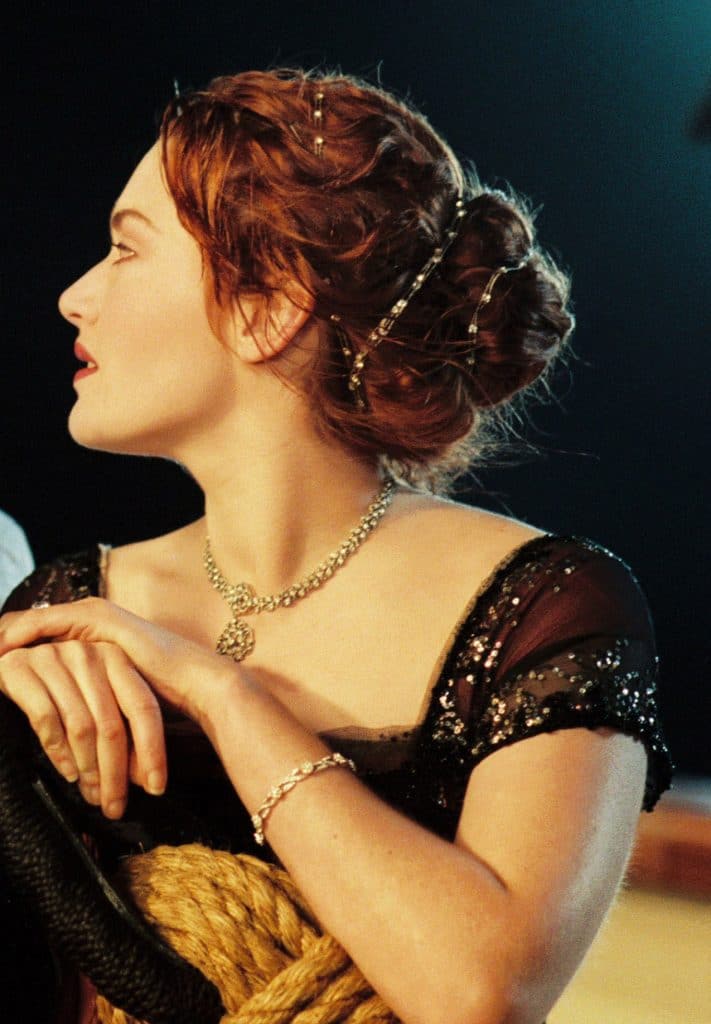
They also wore long white gloves because dinner time was also the time for dance and physical contact was considered to be inappropriate. So gloves were basically a part of a titanic style dress. These gloves were generally elbow length with the short-sleeved dresses and, if the dresses were long-sleeved, they used short gloves or long gloves under their sleeves.
A smart opera bag, silk or satin scarfs, and fans were other accessories they used in the dinner parties.

